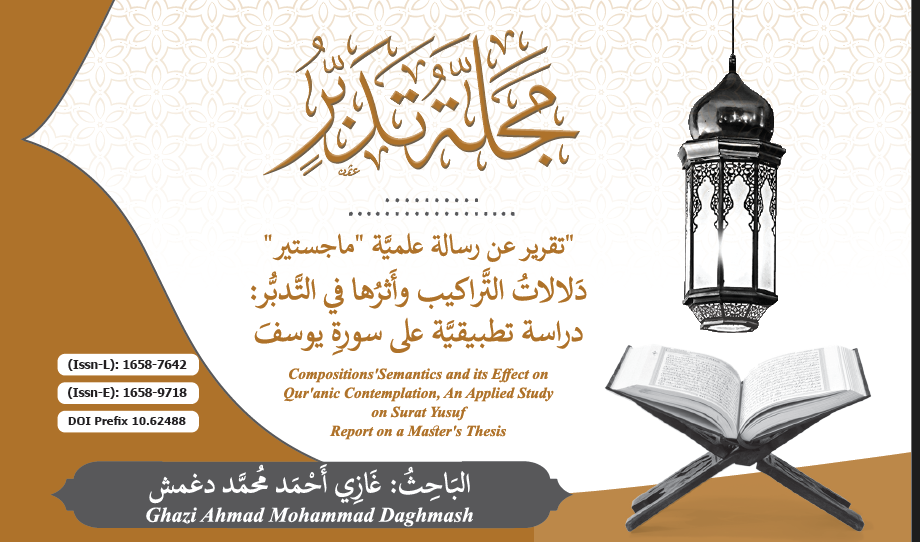Compositions’ Semantics and its Effect on Qur’anic Contemplation, An Applied Study on Surat Yusuf Report on a Master's Thesis
Main Article Content
Abstract
All praise is due to Allah, Lord of the worlds, and peace and blessings be upon the guide of humanity to the Lord of the worlds, Muhammad, the trustworthy, may Allah’s peace and blessings be upon him, his family, his companions, his wives, and his followers until the Day of Judgment.
We are pleased to present in the nineteenth issue of the peer-reviewed academic journal Tadabbur, in its tenth year, a report on a scholarly thesis as part of the journal’s commitment to publishing reports on theses, projects, and academic conferences. These efforts aim to enrich researchers with the latest developments in the academic field, strengthen the connection between scholarly research and the academic community, and accelerate the global dissemination of knowledge through a specialized, peer-reviewed platform focused on Quranic contemplation (tadabbur). This issue features a report on a master’s thesis titled: "The Semantics of Linguistic Structures and Their Impact on Quranic Contemplation: An Applied Study on Surah Yusuf." This thesis highlights the significance of tadabbur and its scholarly and practical applications. The thesis, submitted by the researcher Ghazi Ahmad Muhammad Dughmush at the World Islamic Sciences and Education University, addresses several topics. It begins by defining the concept of tadabbur, traces the emergence of the science of semantics in foundational Islamic texts, categorizes its three divisions after defining and comparing them, establishes the legitimacy of using semantics as evidence, and illustrates its impact on Quranic contemplation by broadening the scope of analyzing its linguistic expressions.
This thesis represents a valuable contribution to the field of Quranic studies and linguistics, as it explores the intrinsic relationship between the semantics of linguistic structures and the process of Quranic contemplation. The research derives its importance from its endeavor to establish a deeper understanding of the Quranic discourse, utilizing semantic tools to analyze the meanings derived from the text. As the thesis emphasizes, tadabbur is not merely a superficial reading but a profound reflective process that engages the intellect and insight to uncover the treasures of guidance, wisdom, and lessons within the Quran.
The researcher has defined the term tadabbur, clarified its linguistic and technical meanings as understood by Quranic exegetes, and outlined its scopes. He also defined the semantics of linguistic structures, distinguished their differences, identified their categories and principles, and noted the earliest scholars who documented them in foundational texts. The researcher established the connections between the discussions of linguistic semantics among scholars of Islamic jurisprudence (usuliyyin) and rhetoricians (bayaniyyin). In the applied section of the thesis, the second chapter is dedicated to an applied study of semantic contemplation of Surah Yusuf (peace be upon him), extracting dozens of contemplative insights through a systematic and disciplined methodology. The study resulted in 210 contemplative insights, one-third of which relate to the science of rhetoric (balagha), while two-thirds pertain to the field of semantics. This underscores the critical importance of the science of semantics in Quranic contemplation.
Downloads
Article Details
Conference Proceedings Volume
Section

This work is licensed under a Creative Commons Attribution-NonCommercial-ShareAlike 4.0 International License.
Indicating to the intellectual property, copyrights, and open access right:
According to the Budapest Initiative 2002; tadabbur Journal, which is issued by Khibrat Taibah For Research and Studies in Medina, provides free open access to its publications, and applies the Creative Commons license:
Attribution- Non-Commercial 4.0 International (CC BY-NC 4.0) for the works it publishes from peer-reviewed scientific research and reports, which are freely available on the Internet, and which allows any user to read, download, copy, and distribute (Convert), print, search, or create links to the full texts of the journal’s research and publications, and analyze them in an automatic manner for discovering them, sending them as software data, or using them for any other legal purpose, without financial, legal, or other technical barriers beyond those related to Internet access.
It also highlight that the only barrier to reproduction and distribution, and the only role of copyright in this field, is the necessity of granting the authors of the journal’s research and reports and the publisher the journal; Control over their works, and the right to official recognition and reference citations.
How to Cite
References
دغمش غازي أحمد محمَّد، بشايرة زكي مصطفى، ومحمود مصطفى محمود. 2025. "دَلالات التراكيب وأثرها في التدبُّر: دراسة تطبيقيَّة على سورة يوسف "تقرير رسالة علميَّة-ماجستير"، مجلة تدبر 10 (19): 350-70.
. https://doi.org/10.62488/1720-0010-019-006
مجلة تدبر. العدد التاسع عشر (المحرم 1447هـ / يوليو 2025م). المدينة المنورة: خبرات طيبة للبحوث والدراسات، 2025م.
Daghmash, Ghazi Ahmad Muhammad, Zakki Mustafa Bashaerah, and Mostafa Mahmoud Mostafa. 2025. "Dalālāt al-Tarākīb wa-Atharuhā fī al-Tadabbur: Dirāsah Taṭbīqiyyah ‘alá Sūrat Yūsuf (Taqrīr Risālah ‘Ilmiyyah – Mājistīr)." Tadabbur Journal 10, no. 19 (July): 350–370. https://doi.org/10.62488/1720-0010-019-006
Tadabbur Journal. *Issue 19 (Muharram 1447 / July 2025) *. Al-Madinah Al-Munawwarah: Khibrat Taybah for Research and Studies, 2025.





